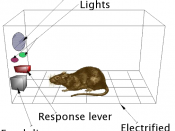Defining human development from a single dimension seems impossible due to the multi faceted nature of human beings. It is crucial to consider that no theory can exclusively determine the behavior of all individuals; however, my choice of Behaviorism, (Hetherington, Parke, & Schmuckler, 2002) most closely suited the population of children available for me to study. Caregivers model language and display emotion (e.g., surprise, anger, sadness, joy, fear, etc.) for infants and children as a form of "conditioning" to exaggerate enunciation or match feelings with language. Children as well as adults mimic and often follow along with the crowd to avoid looking different or being left out. On the job training is a classical example of operant conditioning, as it allows the person to learn by trial and error, receive a reward of an income, and as their skills improve their pay increases over time. I also believe that people have a propensity to respond to extreme social and peer conditioning predictably, as evidenced by incidents involving mass hysteria, like the Vancouver bus episode of a mass socio-genic event.
(Cluff & Mathias, 2004)
Observation subjects were a 3 1/2 year old female named Kelley, a 14-month-old male toddler Keaton, and a 5-year-old male named Chance. All of these children were observed over a period of 1 week in a daycare setting with and without their mother interacting with them. The childcare facility is staffed with two paid staff members and one mother rotates throughout the 4-hour day of structured activities. Many of the mothers have little patience and lack formal parenting skills due to their substance abuse and domestic violence issues. Subsequently their children demonstrate behaviors reflective of circumstances in their homes.
Kelley
This little girl appeared to interact with her peers while playing in the kitchen area of the...


